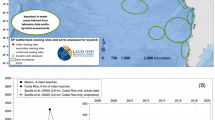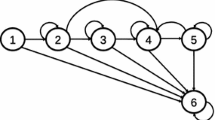Abstract
In 1994, (the World Conservation Union (IUCN) made new quantitative criteria for Red List Categories. Among these, criterion A is based on the reduction rate of population size and is not linked to absolute population size. This is because for most unexploited threatened species absolute population size is completely uncertain. Criterion E is directly concerned with the extinction probability within a specified period. Criterion A is applied to marine fish species, including tuna, which are exploited by commercial fishing. However, for many fish that are commercially exploited, the absolute number of mature individuals and the variance in its yearly reduction rate are often known. In addition, extinction probability depends on absolute population size. There is an inconsistency between criterion A and E when population size is large enough. This is the case for tuna. In this paper, we propose a new criterion for threatened species based on the average reduction rate and the current population size. Criterion A is consistent with criterion E as long as the population size is very small. We also propose a method for estimating the extinction risk of tuna based on the variance of the reduction rate. We investigated the sensitivity in the uncertain parameters involved in the models and concluded that tuna is unlikely to be listed as critically endangered but that southern bluefin tuna may be listed as vulnerable.
Similar content being viewed by others
References
Butterworth D. S., Hughes G. S. &Strumpfer F. (1980) VPA with ad hoc tuning: implementation for disaggregated fleet data, variance estimation, and application to the horse mackerel stock in ICSEAF Divisions 1.3+1.4+1.5.South African Journal of Marine Science 9: 327–357.
Chow S. &Kishino H. (1995) Phylogenetic relationships between tuna species of the genusThunnus (Scombridae: Teleostei): Inconsistent implications from morphology, nuclear and mitochondrial genomes.Journal of Molecular Evolution 41: 741–748.
Chow S. &Uoshima H. (1995) Global population structure of albacore (Thunnus alalunga) inferred by RFLP analysis of the mitochondrial ATPage gene.Marine Biology 123: 39–45.
Clark C. W. (1985)Bioeconomic Modelling and Fisheries Management. Wiley-Interscience, New York.
Edmunds P. H. &Sammons J. L. (1973) Similarity of genetic polymorphism of tetrazolium oxidase in bluefin tuna,Thunnus thynnus, from the Atlantic coast of France and the western North Atlantic.Journal of Fisheries Research Board in Canada 30: 1031–1032.
Hudson E. & Mace G. M. (ed.) (1996)Marine Fish and the IUCN Red List of Threatened Animals Report. Workshop held in collaboration with theWWF and IUCN at the Zoological Society of London, 29 April–1 May 1996, pp. 1–26.
ICCAT (1995)Report for biennial period, 1994–95, Part I, Vol. 2. pp. 1–283.
Ishizuka Y., Takeuchi Y. & Tsuji S. (1995) Assessment of the southern bluefin tuna stock. Document for the first meeting of the Scientific Committee of CCSBT, Shimizu-shi, Japan, 10–19 July 1995, SBFWS/95/18, 82pp.
IUCN (1994)IUCN Red List Categories. IUCN, Switzerland, pp. 1–21.
Karlin S. (1969)A First Course in Stochastic Processes. Academic Press, New York.
Lande R. (1988) Demographic models of the northern spotted owl (Strix occidentalis, caurina).Oecologia 75: 601–607.
Latcavage M. &Kraus S. (1995) The feasibility of direct photographic assessment of giant bluefin tuna,Thunnus thynnus, in New England waters.Fishery Bulletin 93: 495–503.
Mace G. M. &Lande R. (1991) Assessing extinction threats: toward a reevaluation of IUCN threatened species categories.Conservation Biology 5: 148–157.
Mace G. M. & Stuart S. N. (1994) Draft IUCN Red List Categories, Version 2.2.Species 21–22: 13–24.
Mace G. N., Collar N., Cooke J. et al. (1992) The development of new criteria for listing species on the IUCN Red List.Species 19: 16–22.
Myers R. A., Barrowman N. J., Hutchings J. A. &Rosenberg A. A. (1995) Population dynamics of exploited fish stocks at low population levels.Science 269: 1106–1108.
National Research Council (NRC) (1994)An assessment of Atlantic bluefin tuna. Committee to Review Atlantic Bluefin Tuna Ocean Studies Board. National Academy Press, Washington DC, pp. 1–148.
Polacheck T., Sainsbury K. & Klaer N. (1995)Assessment of the status of the southern bluefin tuna stock using virtual population analysis. Document for the first meeting of the Scientific Committe of CCSBT, 10–19 July 1995, Shimizu-shi, Japan, SBFWS/95/17, 90 pp.
Shaffer M. L. &Samson F. B. (1985) Population size and extinction: A note on determining critical population size.American Naturalist 125: 144–152.
Author information
Authors and Affiliations
About this article
Cite this article
Matsuda, H., Yahara, T. & Uozumi, Y. Is tuna critically endangered? Extinction risk of a large and overexploited population. Ecol. Res. 12, 345–356 (1997). https://doi.org/10.1007/BF02529464
Received:
Accepted:
Issue Date:
DOI: https://doi.org/10.1007/BF02529464




